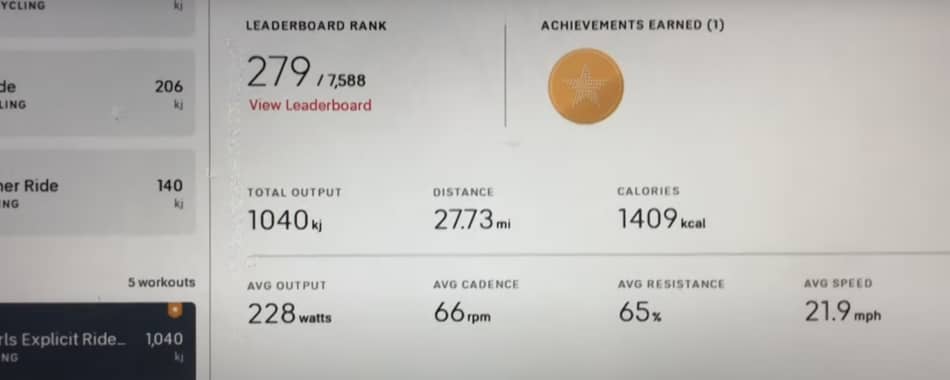Boxing and cycling are two of my favorite ways to stay fit.
In this article, I will explain the difference between the peloton (including peloton boxing) and FightCamp, and help you decide which one should you get.

Peloton and FightCamp are two completely different workouts but they share one thing in common; they both deliver high-intensity home-based training. The FightCamp is an interactive boxing and kickboxing workout, whereas the Peloton is an indoor cycling group class.
Key Takeaways
- FightCamp is an on-demand boxing workout that comes with over 1,000 classes.
- Apart from its fitness content, the company also provides boxing equipment in the form of a punching bag, floor mat, and boxing gloves with motion sensors.
Peloton includes a more also have number of boxing classes that
How does FightCamp works?
The Figthcamp workouts range from 15 to 45 minutes and are based on elements of boxing and kickboxing.
Each class comes with the Total Punch Goal, which is the number of punches you need to reach to complete the workout.
What I like about the Fightcamp app is it synced with the motion sensors in your wrist straps and displays the total number on the screen.
I think seeing how many punches you do per class is highly motivating and fun, which helps you to “forget” that you are working out.
However, what I don’t like is that the number of strikes is the only metric that you get. No power output. No heart rate.
Weight Loss
Peloton and FightCamp are both effective when it comes to weight loss because they offer high-intensity workouts that burn a lot of calories.
However, the peloton has much more variety of classes that covers strength, flexibility, and cardiovascular fitness.
According to the article published in The Journal of Strength & Conditioning Research, “increasing the variety of exercise equipment available to children, young and older adults increased their exercise participation and enjoyment of that exercise without altering their perceived exertion”.
This means that “increasing the variety of exercise may increase people’s exercise adherence,” states the article.
Peloton offers over 24,000 on-demand classes available in 13 different categories.
On the other hand, FightCamp is all about boxing and kickboxing, with only a few elements of HIIT cardio in between the rounds.
Peloton is better
I think the peloton is better than FightCamp for weight loss. It not only covers all aspects of fitness like strength, cardio, and flexibility but also offers significantly more on-demand content.
Boxing classes
Peloton offers only a handful of boxing classes. You can find them in the cardio category under “shadowboxing”.
Apart from that, they also have HIIT cardio workouts with basic boxing exercises like kicks, jabs, and high knees.
On the other hand, the FightCamp class is mainly focused on martial arts.
Each class includes hundreds of hooks, jabs crosses, kicks roundhouse kicks, and uppercuts, all done on the punching bag.
The punching bag exercise is an effective way to get fit.
It not only engages multiple muscle groups it also burns between 100 to 200 calories every 20 minutes (1). It also utilizes both aerobic and anaerobic fitness, depending on the intensity.
I love punching bags because it not only gets me out of breath but also help to relieve stress. I always find myself more calm and relaxed after doing punching bag, compared to cycling or running.
Other classes
The peloton offers a huge selection of both live and on-demand content.
They also have world-famous instructors that manage to create a raving fan community thanks to their charisma and personality.
On the other hand, FightCamp doesn’t have live classes.
However, they do have a number of workouts that specialize in building boxing skills like switch stance workouts or striking workouts.
Here is the comparison between the peloton classes and FightCamp classes.
| Peloton classes | FightCamp classes |
|---|---|
| Meditation Yoga Strength Cardio Walking Stretching Cycling Running Outdoor Bootcamp Boxing | Pure punching Full body Switch stance Pure striking Upper body Knockout power Combo buildup Burnout |
As you can see, the peloton offers traditional and proven fitness genres. On the other hand, I have a feeling that FightCamp is using fancy names around very similar classes.
HOWEVER.
I know many people who don’t have a specific fitness goal (e.g. weight loss) and they simply love to train because exercise makes them feel good. They like fun and challenge.
If that’s the case, I can highly recommend boxing because it is the perfect way to unplug and even train together with your family and friends.
Programs
In Peloton you have access to over 37 programs that range between 1 to 18 weeks.
These programs are ready-made clusters of classes that are designed to get you started with the bike, introduce you to yoga or develop a stronger core.
All these programs implement progressive overload where you slowly increase the training volume and class difficulty.
The FighCamp doesn’t offer multiple-week programs or boxing tutorials. It only offers single workouts that are divided into rounds.
Each class has between 2 to 10 rounds. The rounds differ in the number and type of exercises you do.
I think that FighCamp should implement some type of program tutorials because boxing is a very technical sport and without correct supervision, it can end up in an injury.
What is better for beginners?
The peloton and FighCamp have advantages and disadvantages compared to other on-demand fitness content but they have one thing in common; they’re both beginner-friendly.
Peloton has thousands of classes and programs that are specifically geared toward beginners.
It also has useful metrics and analytics that display things like power zone, heart rate zone, and strive score to help people get motivated.
Now, I still think the Fightcamp is good for beginners because a punching bag is therapeutic.
It also increases the production of endorphins, the neurotransmitters that create feel-good thoughts which can lead to the formation of positive habits.
In other words, boxing not only makes you feel good but also helps to form an exercise habit, faster.
Another thing peloton and Fighcamp share in common is the leaderboard and the ability to track your performance.
Leaderboard
The difference between the peloton leaderboard and FightCamp is that the peloton uses several metrics and gives you detailed analytics of your current and historical performance.
Not only that.
In the picture below you can see my stats like total output, calories burned, avg speed, and avg resistance after the class.

After each class, the peloton app saves the data and compares that with your previous achievements.
On the other hand, the FighCamp counts how many punches you do per workout thanks to the motion sensors in its gloves.
FightCamp does have a leaderboard where you compete against other members in the number of punches per class.
However, apart from punches, it doesn’t measure anything else like heart rate or power output.
Here is the comparison between peloton metrics and FighCamp.
| Peloton metrics | FightCamp metrics |
|---|---|
| Average output Total output Average resistance Average cadence Distance Duration Speed Calories Badges Heart rate zone Power zone | Number of punches Leaderboard position |
As you can see, the peloton bike is head and shoulder above the FighCamp when it comes to analytics and metrics. The FightCamp does have a leaderboard, but it only uses a number of strikes as its performance score.
Membership
Peloton and FightCamp have a similar approach when it comes to their membership plans.
They both offer two options for digital apps only and for hardware + digital app.
With peloton, you can either choose to buy a bike with an all-access membership or just the Peloton digital app with the video content.
With FighCamp whether you buy their standing bag or not, you still have to pay their same $44/month subscription.
Here is the membership table for different Peloton bike options.
| Peloton membership | Price |
|---|---|
| Bike Basic | $1,495 |
| Bike Essential | $1,645 |
| Bike Works | $1,745 |
| Bike Family | $1,945 |
| Peloton All-access | $44/month |
| Peloton Digital | $12.99/month |
As you can see, the peloton does come with four packages and the difference between them is in additional equipment like dumbbells, a reverse exercise mat, and a water bottle.
They also have a second membership option for $12.99/month if you only want to use their content from the app.
Here is the comparison of the FighCamp subscription offer.
| FightCamp membership | Price |
|---|---|
| FightCamp Personal | $999 |
| FightCamp Tribe | $1,299 |
| FighCamp Connect | $399 |
| Monthly membership | $39/month |
As you can see, the FighCamp gives you 3 different ways to get started, with or without their main standing punching bag.
I think this offer is less favorable to peloton because the price for a monthly subscription is the same, but peloton offers significantly more value.
Conclusion
I believe that peloton is a much better option compared to FighCamp because not only do they have more variety of classes, but also have better software with more metrics and analytics.
Having access to things like power output, calorie expenditure, resistance, and more allows you not only to compete against yourself but also to track and design a smart workout plan.
